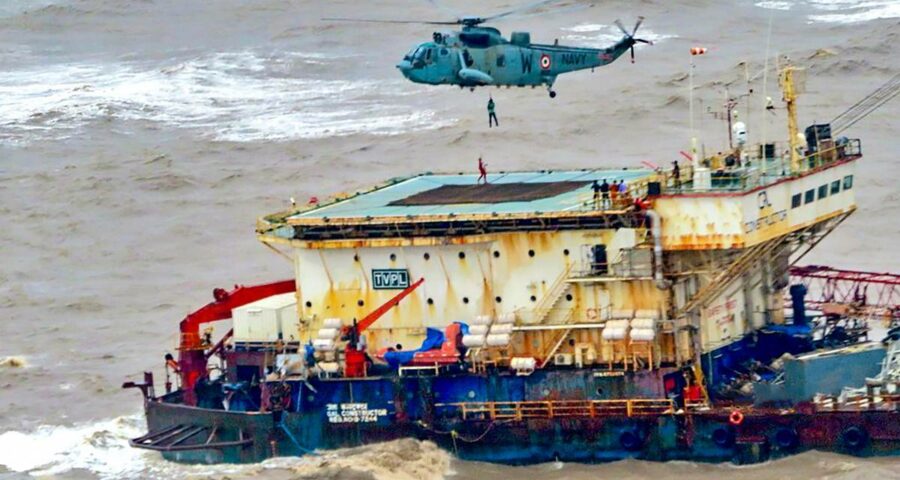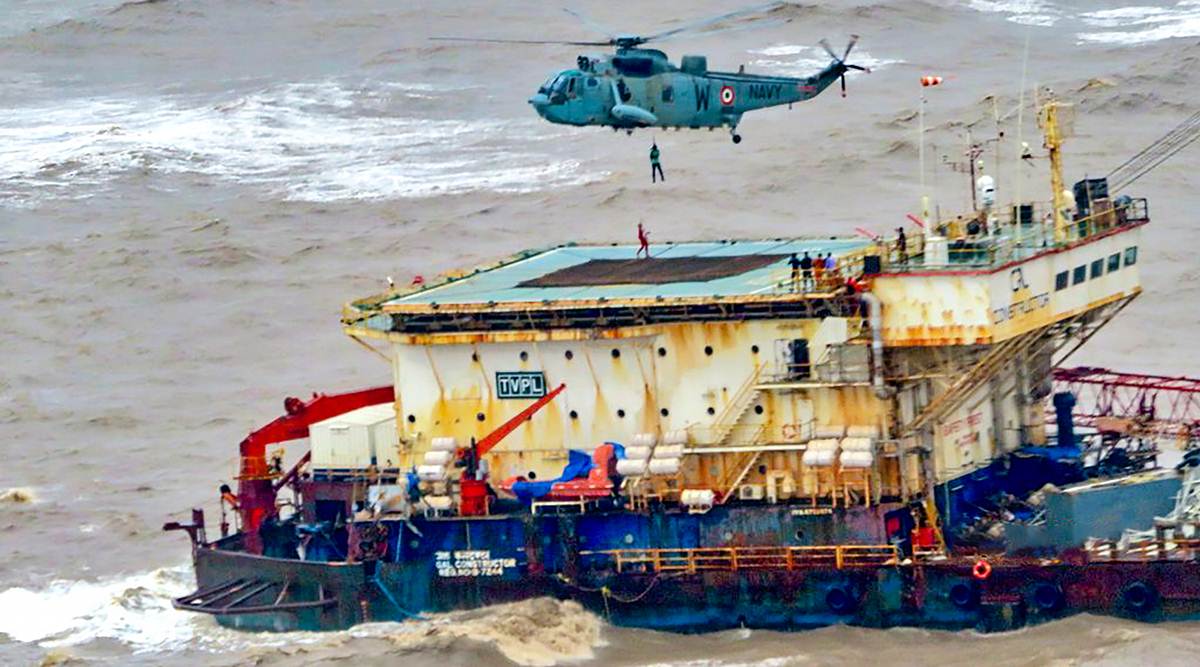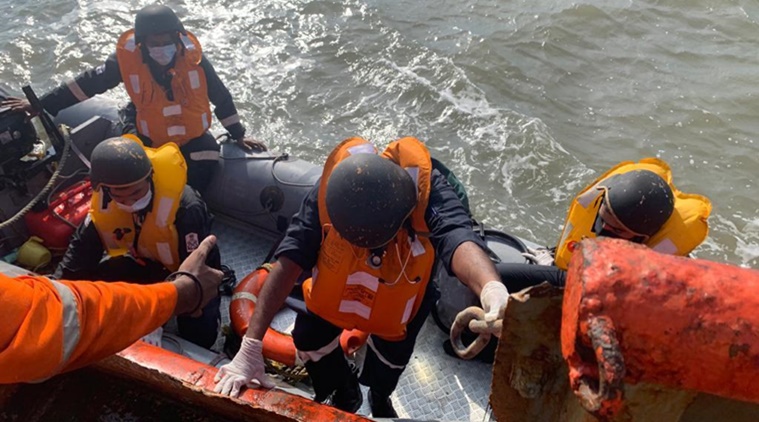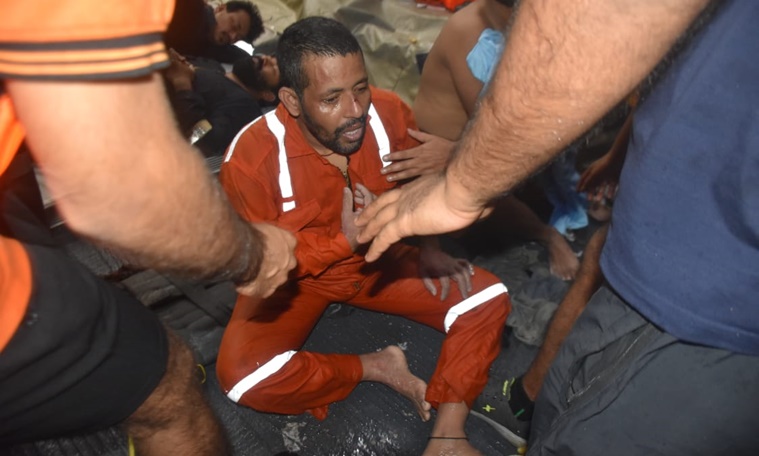Awal said ONGC had 99 vessels in the sea, of whom 94 had come back paying heed to weather warnings, but not P305. It said it has an emergency management system and warnings from statutory bodies, including the Coast Guard, had been forwarded to all the vessels.
Barge P305, the vessel doing work for the ONGC that crashed into a rig off Mumbai during Cyclone Tauktae and sank, leading to the death of at least 49 people on board, had broken free of its anchor shortly after midnight on May 16. Had this information been passed on to the Mumbai-based Digital Communication (DGCOM) Centre of the Ministry of Shipping, a rescue effort could have been mounted much earlier, top sources in the ministry told The Indian Express.
The DGCOM Centre was informed only at 10 am on May 17, by which time the cyclone had already entered the Mumbai coastal area, sources said. The barge had started sending distress signals too by then. Coast Guard, Navy and merchant vessels were diverted to its location only mid-morning. The barge finally sank around 5 pm, and the cyclone made landfall at Gujarat four hours later.
Sources said the barge had broken free of its moorings due to the high-speed winds and choppy sea, that had set in before the cyclone.
Asked about the DGCOM Centre not being informed, ONGC spokesperson Harish Awal said he was not aware of the matter. Instead, both ONGC, and its contractor Afcons Infrastructure, that was doing building work for the state-owned company and had chartered P305, laid the blame at the door of the Master or Captain of the barge, who is among the 26 from the vessel still missing. Of the 261 people onboard, 186 have been rescued.
Awal said ONGC had 99 vessels in the sea, of whom 94 had come back paying heed to weather warnings, but not P305. It said it has an emergency management system and warnings from statutory bodies, including the Coast Guard, had been forwarded to all the vessels.
“We are not mariners, we are oil and gas experts,” an ONGC official said, noting that besides sharing the advisories, the company had recommended that all vessels move to a safe location.
In a statement, Afcons said that the Master of P305, Balwinder Singh, decided to move the barge only 200 metres away from the platform where it was operating even as other vessels moved closer to safe harbours based on its advice. The predicted maximum wind speeds of 40 knots (about 75 km/hr) and the barge’s location being about 120 nautical miles (222 km) from the anticipated eye of the storm led the Master to believe they were safe, the company said. Singh reportedly understood the cyclone to be a “tropical storm”.
Afcons also said that decisions regarding safety of the vessel were the responsibility of Durmast Enterprises, the owners of the barge.
However, officials at the Shipping Ministry are asking why ONGC and Afcons allowed the Master to have his way when both the India Meteorological Department and Coast Guard had issued several warnings.
Durmast could not be contacted. An official said the ongoing inquiry would also look into why all the 32 life rafts and 600 life jackets onboard the barge were not used.
The Chief Engineer of the barge, Rahman Shaikh, who was rescued on Wednesday and is hospitalised, told The Indian Express on Wednesday that 14 of the 16 rafts that the men checked were unusable as they had holes in them.
Sources said all vessels such as P305 are equipped with a global maritime safety distress system and given advice twice a day on the weather — increased to one every two hours in case of adverse conditions.
Sources said the DGCOM Centre now also has a system called Maritime Merchant Domain Awareness, to detect ships in the path of a cyclone. Used for the first time, it helped remove 12 from the path of Tauktae. P305 was not on the radar as it was not in the path of the cyclone.
However, officials said, the Coast Guard had given P305 a specific warning to move back to harbour, as even if vessels are not directly in a cyclone’s path, wind speeds can make render a vessel unsafe, especially flat-bottomed ones like barges that cannot withstand anything more than 20 knots or 40 kmph.
“Finally it is the decision of the Master, and in many cases, the owner of the ship forces him to stay back,” said sources.
Afcons said there were 1,241 employees on board the six barges chartered by it in the area, and it had shared forecasts regarding Tauktae with them on May 14, recommending that they secure their operations and move to a “safe location at the earliest”. Following the advice, five of the barges moved to the Mumbai port or outer anchorage, or anchorage close to Revandanda, but not P305.
The weather forecasts predicted maximum wind speeds of about 40 knots between late May 16 and early May 17, but actual wind speeds rose to nearly 150-180 km/hr. Afcons said that once weather conditions deteriorated, it “left no time at all for any further action to be taken by the Master (of P305)”.
The company said the barge Master is responsible for the safety of a vessel under normal marine protocol as he is “in the best position to decide on the appropriate course of action regarding vessel safety”. “As per the international standard vessel chartering terms which were adopted for the charter of P305, the responsibility for the marine side of the operations, namely safe vessel operation, navigation and vessel management, come under the scope of work of the vessel owners,” the Afcons statement said.
Source: Read Full Article




